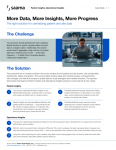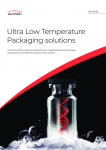Guest article
3 global trends driving transformations in healthcare product development

The dual forces of unmet medical need and economic sustainability are important factors driving these transformations. Outsourcing has become a powerful tool to optimize costs and timelines at all levels of healthcare product development.
Speed, agility, and efficiency can increase when expensive services and infrastructure are outsourced, shared, or avoided entirely. However, varying levels of outsourcing, collaboration, and sharing also bring with them challenges that may be at odds with the ultimate goal of improving patient outcomes.
To provide patients with optimal care in an era of increased globalization and outsourcing, successful organizations will build partnerships that leverage these trends to deliver life-saving therapies to patients and maintain the economic vitality of the product development ecosystem.
The Big Three
Globally, three trends have the potential to affect patient outcomes as various steps of healthcare product development and delivery are outsourced or shared:
- Increased coordination by global regulatory agencies
- Industry consolidation
- Patient-centered product development
Although at first glance these trends appear disconnected, they constitute three structural undercurrents, each of which ultimately affect the patient and the organizations that are part of the healthcare product development ecosystem.
In the global regulatory landscape, multiple countries and regions have taken steps to harmonize and streamline their regulatory processes. Participation by national regulatory agencies in international efforts, such as the International Coalition of Medicines Regulatory Authorities (ICMRA) and the International Council for Harmonisation (ICH), has grown beyond the founding nations in North America, Europe, and Asia (Japan) to now encompass most major markets.
China, in particular, has steadily implemented a series of sweeping reforms to its regulatory framework, culminating in the country joining the ICH this year. China has been a popular outsourcing destination for years, but with China joining the global regulatory community, the country also emerges as an even more attractive location for clinical trials and Contract Research Organizations (CROs).
Optimizing healthcare product development across this global ecosystem requires organizations to have global reach and scale. Over the past few years, CROs have been consolidating, and in 2017, this trend has accelerated as CROs are competing to provide end-to-end product development and commercialization services at a global scale.
Today, the top 10 CROs control more than half of the global market, a trend that is expected to increase over the next few years. These mergers have the potential to enable CROs to boost their efficiency and combine their therapeutic expertise to offer a much wider range of services. While this is a positive development, the industry does face new challenges.
These close relationships should increase efficiency but could slow the extraordinary rate of innovation we have seen from CROs as they competed for sponsors. In addition, mergers have the potential to disrupt or delay ongoing work, distracting from patient focus or putting patients in peril.
Ultimately, the goal driving everyone who works in healthcare product development is helping patients live longer, healthier lives. Although the pace is uneven, patient-centered drug development is moving from aspiration to implementation.
While pharma and biotech leaders, as well as regulatory agencies, are committed to the aspiration, implementation remains challenging in a global ecosystem where drug development requires collaboration across multiple companies, cultures, and technology platforms.
As implementation practices mature and global outsourcing trends unfold, sponsors and patients will be asking where patient input provides the most value in terms of development costs, time-to-market, adherence, and efficacy.
Many leading CROs are already incorporating patient-centricity into their practices to improve, among other things, the clinical trial experience for patients – a move that occurred both in response to their sponsors’ aspirations and via their own cutting-edge leadership activities.
Research and development organizations, like CROs, live at the interface of the three global trends discussed above and are well positioned to act as liaisons between sponsors, patients, and even regulators, enabling them to work toward optimizing outcomes for patients and sponsor companies alike.
In the end, success will come to those who build partnerships leveraging these trends to improve patient outcomes and foster a sustainable healthcare product development ecosystem.
























